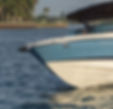

Nov 26, 2025


Nov 19, 2025
Updated: Oct 27, 2023

You may have noticed some of the newer boats currently being offered are using a square bow, as opposed to one that slopes forward.
It is an interesting concept and one that is not new. We first saw boats with vertical bow designs over 100 years ago on many of the now antique lake boats.
So what motivated boat designers to bring back vertical bows? The answer is found in what happens when a bow runs into a wave, or wake.
Most waves have a hump shape. The leading edge of the wave begins at or below water level and gradually increase in steepness, up to the crest. The majority of the small boats we see on the water today, have a fore deck that extends forward of the boat hull beneath it. This means that the angle of the leading edge of the boat bow will be close to the angle of the leading side of the wave it encounters. When a typical runabout of today with this sloping bow runs into a wave, and the angle of the wave is similar to the angle of the boat bow, a considerable portion of the bow impacts the wave at the same time.

If the boat is at speed, or the wave is large, the resulting impact is significant. Striking the wave with a sloped bow, the boat can be pushed upwards, only to fall back into the water with second impact.
Now imagine a boat with a vertical bow running into the same wave.
Entering the wave, the bow does not strike at a similar angle to the wave. Instead, the lower portion of the bow enters the wave first and then the wave strikes higher up the vertical bow with considerably less impact. The bow actually cuts into the wave and the wave provides additional stability. For this reason, a vertical bow provides a more comfortable ride.
Why then, you may ask, did most pleasure boats evolve their bow designs into the forward slope we see today? The answer is that an angle at the bow of a boat helps the boat drive up onto plane. Also, a pointed bow adds overall length to a boat without the cost of adding more usable space. Finally, most boaters believe the looks of a pointed bow to be more visually pleasing than a blunt vertical design.

The ideal design would be one that combines the benefits of both vertical and sloped bow design. And that is exactly what the latest bow designs are doing. We are seeing vertical bows that cut through waves at slow to medium speeds, which are the speeds we normally run when cruising, but below the vertical portion of the bow, we see a curve in the hull that helps push the boat upwards as power is added and keeps it up when running at higher speeds.
As I have noted, many early wooden lake boats employed a vertical bow. This leading edge was generally made from steel and was called a “Cut-Water.” This design worked well for these earlier boats, primarily because they didn’t have the power to push themselves up onto a full plane to ride above small waves. Now, with some of the new design features in today’s boats, we see more vertical bows being used in their design. Because this bow design will strike a wave at the lower section of the bow first and then move up to impact the vertical bow more gradually, you will experience a smoother ride. The ability to cut smoothly through waves and wakes is a strong benefit. Especially with a sloped hull below the vertical bow, allowing the boat to ride up and along the top of the water when waves are not an issue. The vertical bow has run full circle in the history of boat design. Keep the benefits of this feature in mind when looking for your next boat. #tips #culture




